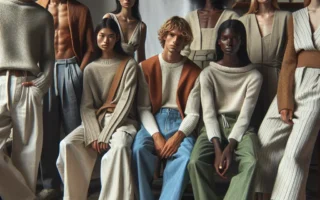History of Sustainable Fashion
Sustainable fashion has a rich history that dates back to the early 20th century, when the concept of ethical and environmentally friendly clothing first began to emerge. In the 1930s, during the Great Depression, people started repurposing and mending their clothes out of necessity, laying the groundwork for the sustainable fashion movement. The 1960s and 1970s saw a rise in eco-consciousness, with the hippie counterculture promoting natural fibers, DIY fashion, and a rejection of mass-produced clothing.
However, it wasn’t until the late 1980s and early 1990s that sustainable fashion began to gain significant traction. Pioneering designers and activists started advocating for sustainable practices in the fashion industry, raising awareness about the environmental and social impact of fast fashion. As consumer awareness grew, the demand for eco-friendly and ethical clothing increased, leading to the establishment of sustainable fashion brands and the integration of sustainable principles into mainstream fashion.
Today, sustainable fashion continues to evolve, with technological advancements and innovative practices driving the industry forward. From upcycling and zero-waste manufacturing to the use of organic and regenerative materials, the history of sustainable fashion has paved the way for a more conscious and responsible approach to clothing production and consumption.
Current Trends in Sustainable Fashion
The current trends in sustainable fashion are driven by the increasing awareness of environmental and social issues within the fashion industry. One prominent trend is the rise of eco-friendly and organic materials, such as organic cotton, hemp, and recycled fabrics. Brands are also exploring innovative materials like pineapple leather and mushroom leather as sustainable alternatives to traditional animal-derived leather.
Another key trend is the adoption of circular fashion practices, which focus on reducing waste and extending the lifespan of clothing through initiatives like clothing rental, resale platforms, and clothing swaps. Additionally, there is a growing emphasis on transparency and ethical production processes, with consumers demanding greater visibility into the supply chain and production methods of their clothing.
Furthermore, the emergence of technology in sustainable fashion is notable, with the use of 3D printing, digital design tools, and blockchain technology to enhance transparency and traceability. Collaborations between fashion brands and sustainable initiatives, as well as the incorporation of indigenous and traditional craftsmanship, are also shaping the current landscape of sustainable fashion.
Overall, the current trends in sustainable fashion reflect a shift towards more conscious and responsible practices, driven by consumer demand for ethical and environmentally friendly clothing options.
Sustainable Fashion: Material Innovations
In recent years, sustainable fashion has gained significant momentum, leading to a rise in innovative material practices within the industry. Consumers are now more conscious of the environmental impact of their clothing, which has prompted fashion brands to explore sustainable materials as an alternative to traditional textiles.
One of the key material innovations in sustainable fashion is the use of organic cotton. Unlike conventional cotton, organic cotton is grown without the use of synthetic pesticides and fertilizers, reducing its environmental footprint. Additionally, the production of organic cotton promotes better soil health and helps conserve water, making it a more sustainable choice for clothing production.
Another emerging trend is the development of fabrics made from recycled materials. This includes recycled polyester, which is often derived from post-consumer plastic bottles. By repurposing plastic waste into clothing, fashion brands are able to reduce the amount of plastic ending up in landfills and oceans, while also lowering the demand for virgin polyester production, which is energy-intensive and contributes to the depletion of non-renewable resources.
Furthermore, innovations in textile engineering have led to the creation of innovative sustainable materials such as Tencel, a fabric made from wood pulp sourced from sustainably managed forests. Tencel production uses an environmentally friendly closed-loop process, where solvents are recycled and reused, resulting in minimal waste and water consumption. This eco-friendly approach to fabric production aligns with the principles of sustainable fashion and offers a renewable alternative to traditional textiles.
As sustainability continues to shape the fashion industry, material innovations play a crucial role in driving the shift towards more eco-conscious practices. By embracing these sustainable materials, fashion brands can reduce their environmental impact and provide consumers with stylish, ethical clothing options that align with their values.
Ethical Practices in the Fashion Industry
As the fashion industry continues to shift towards sustainability, ethical practices have become a key focus for many brands and consumers. The rise of sustainable fashion has brought significant attention to the ethical implications of the industry, including the treatment of workers, the use of environmentally friendly materials, and the overall impact on the planet.
One of the most important aspects of ethical practices in the fashion industry is the fair treatment of workers. Many fashion brands are now seeking certification to ensure that their garments are produced in factories that provide fair wages, safe working conditions, and respect for human rights. Consumers are increasingly demanding transparency in the production process and are supporting brands that prioritize the well-being of their workers.
Additionally, the use of sustainable and environmentally friendly materials has become a major focus for ethical fashion practices. This includes the adoption of organic cotton, recycled fabrics, and innovative materials that have minimal impact on the environment. By embracing these materials, fashion brands can reduce their carbon footprint and contribute to the conservation of natural resources.
Furthermore, ethical practices in the fashion industry involve minimizing waste and reducing the environmental impact of clothing production. This can be achieved through the implementation of circular economy principles, such as designing durable and long-lasting garments, offering repair services, and promoting recycling initiatives. By extending the lifespan of clothing and minimizing waste, fashion brands can significantly reduce their environmental footprint.
In conclusion, the rise of sustainable fashion has brought ethical practices to the forefront of the industry. Brands that prioritize fair treatment of workers, the use of environmentally friendly materials, and sustainable production methods are gaining recognition and support from consumers who are increasingly conscious of the ethical implications of their fashion choices.
Consumer Behavior and Sustainable Fashion
The rise of sustainable fashion has been accompanied by a shift in consumer behavior towards more environmentally friendly and ethically produced clothing. Consumers are becoming increasingly aware of the impact of their fashion choices on the environment and are actively seeking out sustainable alternatives. This shift in consumer behavior can be attributed to a growing concern for environmental issues, as well as the availability of information about the harmful effects of fast fashion on the planet.
One of the key trends in consumer behavior and sustainable fashion is the desire for transparency and ethically sourced products. Consumers are demanding more information about the production processes, materials used, and the overall environmental impact of the clothing they purchase. This has led to an increase in the popularity of brands that are committed to transparency and ethical practices, as well as the rise of certifications and labels that verify a product’s sustainability credentials.
Another important aspect of consumer behavior in sustainable fashion is the preference for quality over quantity. Instead of constantly chasing the latest trends and buying disposable clothing, consumers are now opting for timeless pieces that are well-made and durable. This shift towards a more thoughtful and intentional approach to fashion consumption is driving the demand for sustainable and ethically produced clothing.
Additionally, the increasing availability of sustainable fashion options and the efforts of brands to make eco-friendly choices more accessible have also contributed to the changing consumer behavior. As sustainable fashion becomes more mainstream, consumers are presented with a wider range of choices, making it easier for them to align their fashion preferences with their values.
In conclusion, consumer behavior plays a crucial role in the rise of sustainable fashion. As consumers continue to prioritize transparency, quality, and ethical practices, the fashion industry is being compelled to adapt and embrace more sustainable and responsible approaches to production and consumption.
The Future of Sustainable Fashion
As we look towards the future of sustainable fashion, it’s clear that the industry is undergoing a transformation towards more environmentally friendly and ethical practices. One of the key trends that we can expect to see shaping the future of sustainable fashion is the use of innovative and sustainable materials. Designers are increasingly turning to organic cotton, hemp, and recycled fabrics to create stylish and eco-friendly clothing. This shift towards sustainable materials not only reduces the environmental impact of the fashion industry but also promotes greater transparency and ethical sourcing.
Another important aspect of the future of sustainable fashion is the implementation of circular fashion models. This concept emphasizes the importance of minimizing waste and maximizing the lifespan of clothing. Companies are exploring initiatives such as clothing rental, resale platforms, and take-back programs to encourage a more circular approach to fashion consumption. By extending the life cycle of garments and reducing the volume of textile waste, these practices contribute to a more sustainable and circular fashion economy.
Technology is also playing a significant role in shaping the future of sustainable fashion. Advancements in 3D printing, biotechnology, and innovative production methods are paving the way for more sustainable and efficient manufacturing processes. This not only reduces the environmental footprint of fashion production but also opens up new possibilities for creating unique, customizable, and sustainable clothing.
Furthermore, consumer awareness and demand for sustainable fashion are driving forces that will continue to shape the industry. As more consumers prioritize ethical and sustainable choices, fashion brands are compelled to adopt greener practices and transparent supply chains. This shift in consumer behavior is encouraging greater accountability and sustainability throughout the fashion ecosystem.
In conclusion, the future of sustainable fashion holds great promise, with a growing emphasis on innovative materials, circular fashion models, technological advancements, and evolving consumer preferences. By embracing these trends and practices, the fashion industry is moving towards a more sustainable and ethical future.



